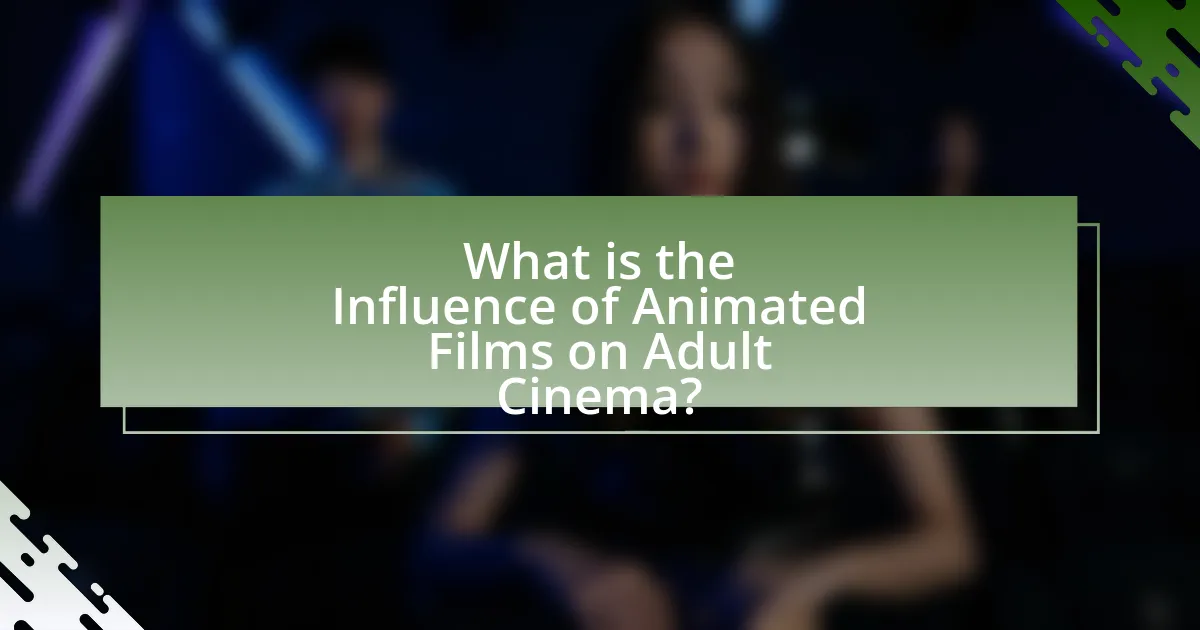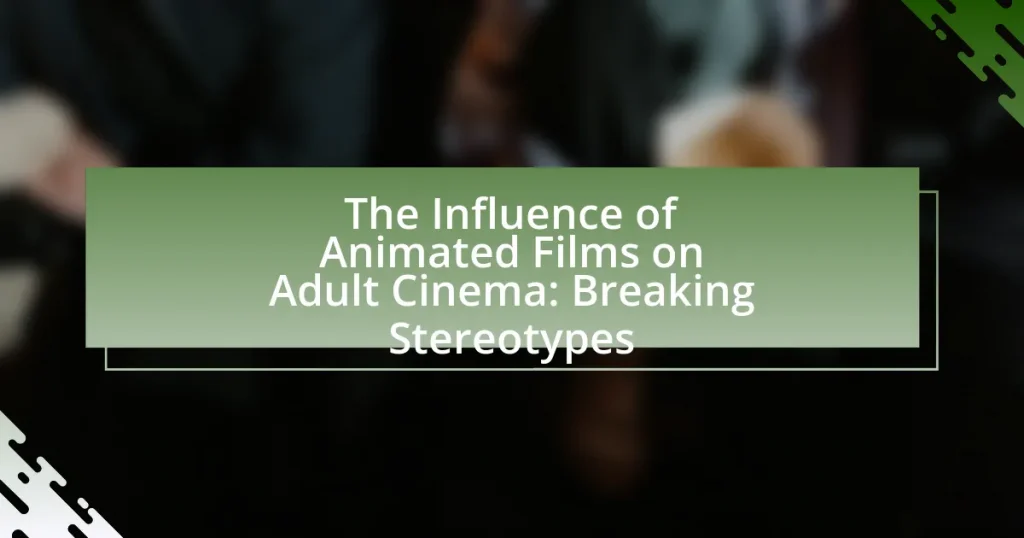The article examines the influence of animated films on adult cinema, highlighting how animation expands narrative possibilities and visual storytelling techniques. It discusses key films that have historically impacted adult cinema, such as “The Simpsons Movie” and “Waltz with Bashir,” which challenge traditional storytelling methods and stereotypes. The article also explores themes of identity, self-discovery, and humor in animated films, illustrating how these elements resonate with adult audiences and redefine character representation. Additionally, it addresses the broader societal implications of this intersection, emphasizing the importance of diverse narratives and the potential for animated formats to tackle complex themes in a relatable manner.

What is the Influence of Animated Films on Adult Cinema?
Animated films significantly influence adult cinema by expanding narrative possibilities and visual storytelling techniques. The incorporation of animation in adult films allows for creative expression that can tackle complex themes, often in ways that live-action cannot achieve. For instance, films like “Waking Life” and “A Scanner Darkly” utilize rotoscoping to blend philosophical narratives with unique visual styles, demonstrating how animation can enhance thematic depth. Additionally, the success of animated features like “The Simpsons Movie” and “South Park: Bigger, Longer & Uncut” showcases how animated storytelling can engage adult audiences, breaking traditional stereotypes about animation being solely for children. This shift has led to a broader acceptance of animated elements in adult-oriented narratives, influencing filmmakers to explore diverse genres and styles.
How have animated films historically impacted adult cinema?
Animated films have historically impacted adult cinema by expanding narrative possibilities and challenging traditional storytelling methods. For instance, the success of films like “The Simpsons Movie” and “South Park: Bigger, Longer & Uncut” demonstrated that animated features could tackle complex themes and adult humor, influencing live-action films to adopt similar bold approaches. Additionally, the rise of adult-oriented animated series in the late 20th century, such as “Fritz the Cat,” which was the first animated feature to receive an X rating, paved the way for more mature content in both animation and live-action cinema. This shift has encouraged filmmakers to explore diverse genres and themes, ultimately enriching the cinematic landscape.
What key animated films have influenced adult cinema trends?
Key animated films that have influenced adult cinema trends include “Heavy Metal,” “The Simpsons Movie,” and “Waltz with Bashir.” “Heavy Metal,” released in 1981, showcased adult themes and graphic content, paving the way for more mature storytelling in animation. “The Simpsons Movie,” released in 2007, demonstrated the potential for animated films to appeal to adult audiences while maintaining humor and social commentary. “Waltz with Bashir,” released in 2008, utilized animation to explore complex themes of memory and trauma, influencing how adult cinema can address serious subjects through animated formats. These films collectively illustrate the evolution of animated storytelling, impacting adult cinema by broadening thematic exploration and audience engagement.
How do animated films challenge traditional adult film narratives?
Animated films challenge traditional adult film narratives by employing imaginative storytelling techniques and diverse character representations that often defy conventional norms. Unlike traditional adult films, which frequently rely on predictable plots and stereotypical characters, animated films can explore complex themes such as identity, morality, and societal issues in a more nuanced manner. For instance, films like “Waltz with Bashir” and “Persepolis” utilize animation to address heavy topics like war and personal trauma, allowing for a unique emotional resonance that traditional adult films may struggle to achieve. This innovative approach not only broadens the narrative scope but also invites audiences to engage with the material on a deeper level, thereby redefining expectations within the genre.
Why is the intersection of animated films and adult cinema significant?
The intersection of animated films and adult cinema is significant because it challenges traditional boundaries of storytelling and audience perception. Animated films, often associated with children’s entertainment, have evolved to explore complex themes and adult-oriented narratives, thereby expanding the scope of what animation can represent. For instance, films like “Waltz with Bashir” and “Anomalisa” utilize animation to convey deep emotional and psychological experiences that resonate with adult audiences, illustrating that animation can effectively address mature subjects. This shift not only broadens the artistic possibilities within the medium but also encourages a reevaluation of stereotypes surrounding both animation and adult content, fostering a more inclusive understanding of cinematic expression.
What stereotypes in adult cinema are being challenged by animated films?
Animated films challenge several stereotypes prevalent in adult cinema, particularly those related to gender roles, body image, and sexual orientation. For instance, traditional adult films often depict women in submissive roles and emphasize unrealistic body standards; animated films, however, frequently portray female characters as empowered and diverse in body types, thereby promoting a more inclusive representation. Additionally, animated films often explore LGBTQ+ themes and relationships in a nuanced manner, countering the heteronormative narratives typically found in adult cinema. This shift is supported by examples such as “BoJack Horseman,” which addresses complex issues of identity and sexuality, demonstrating that animated storytelling can effectively challenge and redefine stereotypes in adult content.
How does this influence reflect broader societal changes?
The influence of animated films on adult cinema reflects broader societal changes by challenging traditional narratives and expanding the representation of diverse themes and characters. This shift indicates a growing acceptance of animation as a legitimate medium for adult storytelling, paralleling societal movements towards inclusivity and complexity in character development. For instance, films like “Spider-Man: Into the Spider-Verse” have not only garnered critical acclaim but also showcased varied cultural backgrounds and identities, mirroring the increasing demand for representation in media. This evolution in animated storytelling aligns with broader trends in society that advocate for diversity and the dismantling of stereotypes, as evidenced by the rise of films that address social issues and promote empathy among audiences.

What are the key themes in animated films that resonate with adult audiences?
Key themes in animated films that resonate with adult audiences include existentialism, identity, and the complexity of relationships. Existentialism is often explored through characters facing profound questions about purpose and existence, as seen in films like “Waking Life.” Identity themes are prevalent, with narratives that delve into self-discovery and personal growth, exemplified by “Inside Out,” which addresses emotional complexity. Additionally, the complexity of relationships is portrayed through nuanced storytelling, as demonstrated in “Up,” where themes of love, loss, and companionship are intricately woven into the narrative. These themes engage adult viewers by reflecting their own life experiences and emotional challenges.
How do themes of identity and self-discovery appear in animated films for adults?
Themes of identity and self-discovery prominently appear in animated films for adults through complex character arcs and narrative structures that explore personal growth and existential questions. For instance, films like “Waking Life” and “Inside Out” delve into the intricacies of human emotions and the search for self, illustrating how characters navigate their inner conflicts and societal expectations. These narratives often employ surreal visuals and innovative storytelling techniques to engage viewers in a deeper reflection on their own identities. Research indicates that animated films can effectively convey profound themes due to their ability to blend fantasy with relatable human experiences, allowing audiences to confront and reflect on their own journeys of self-discovery.
What examples illustrate the exploration of identity in these films?
Animated films such as “Inside Out” and “Coco” illustrate the exploration of identity by delving into the complexities of emotions and cultural heritage. In “Inside Out,” the personification of emotions showcases how internal experiences shape an individual’s identity, emphasizing the importance of acknowledging and integrating various feelings for personal growth. “Coco” explores identity through the lens of family and cultural legacy, highlighting how connections to ancestors and traditions influence one’s sense of self. Both films provide a narrative framework that encourages viewers to reflect on their own identities, supported by the emotional depth and cultural contexts presented in the stories.
How do these themes compare to those in traditional adult cinema?
The themes in animated films often challenge traditional adult cinema by incorporating elements of fantasy, humor, and social commentary, which are less prevalent in conventional adult films. For instance, animated films frequently explore complex narratives and character development, allowing for a broader range of emotional expression and societal critique. In contrast, traditional adult cinema typically focuses on explicit content with less emphasis on storytelling or thematic depth. This distinction highlights how animated films can break stereotypes by presenting adult themes in innovative ways, as seen in works like “Waltz with Bashir,” which addresses war and trauma through animation, contrasting sharply with the often superficial narratives found in traditional adult films.
What role does humor play in bridging animated films and adult cinema?
Humor serves as a crucial mechanism that connects animated films and adult cinema by enabling complex themes to be presented in an accessible manner. Animated films often utilize humor to address mature topics, making them palatable for a wider audience, including adults. For instance, films like “The Simpsons Movie” and “South Park: Bigger, Longer & Uncut” employ satire and comedic elements to critique societal norms and politics, which resonates with adult viewers. This blending of humor allows animated films to explore adult themes without alienating audiences, thereby bridging the gap between the two genres.
How does humor in animated films differ from that in adult films?
Humor in animated films typically relies on visual gags, slapstick, and family-friendly themes, while humor in adult films often incorporates more mature, explicit content and complex social commentary. Animated films, such as those produced by Pixar or Disney, utilize exaggerated expressions and situations to appeal to a broad audience, including children, which necessitates a lighter, more whimsical approach to humor. In contrast, adult films, like those from Judd Apatow or Seth Rogen, often explore themes of sexuality, relationships, and societal norms, using humor that can be provocative or satirical. This distinction is evident in the content ratings, where animated films are generally rated G or PG, while adult films are rated R or NC-17, reflecting the target demographics and the nature of the humor presented.
What impact does humor have on audience reception and stereotype breaking?
Humor significantly enhances audience reception and aids in breaking stereotypes. When humor is effectively integrated into narratives, it fosters a more engaging and relatable experience for viewers, making them more receptive to the underlying messages. Research indicates that humor can reduce defensiveness and promote openness, allowing audiences to confront and reconsider their preconceived notions. For instance, a study published in the journal “Psychological Science” by authors such as Jennifer A. M. K. and others found that humorous content can lead to greater acceptance of diverse perspectives by disarming biases. This mechanism is particularly effective in animated films, where humor can challenge societal norms and stereotypes in a way that feels accessible and entertaining, ultimately contributing to a shift in audience attitudes.

How do animated films redefine character representation in adult cinema?
Animated films redefine character representation in adult cinema by allowing for more diverse and complex portrayals that challenge traditional stereotypes. Unlike live-action films, animated features can create characters that transcend physical limitations and societal norms, enabling the exploration of themes such as identity, sexuality, and mental health in nuanced ways. For instance, films like “BoJack Horseman” and “Big Mouth” tackle adult issues through anthropomorphic characters and exaggerated scenarios, providing commentary on real-life struggles while maintaining relatability. This approach not only broadens the scope of character representation but also encourages audiences to engage with difficult topics in a more accessible format.
What types of characters are commonly portrayed in animated films aimed at adults?
Animated films aimed at adults commonly portray complex characters such as anti-heroes, flawed protagonists, and satirical representations of societal norms. These characters often grapple with moral ambiguity, personal struggles, and existential themes, reflecting the complexities of adult life. For instance, films like “BoJack Horseman” feature a washed-up actor dealing with addiction and depression, while “Fritz the Cat” presents a satirical take on counterculture and sexuality. Such portrayals challenge traditional stereotypes and provide deeper narratives that resonate with adult audiences, showcasing the medium’s capacity for mature storytelling.
How do these character portrayals differ from those in conventional adult films?
Character portrayals in animated films differ from those in conventional adult films by emphasizing depth, complexity, and relatability rather than relying on stereotypes and superficial traits. Animated films often present characters with nuanced backstories and emotional arcs, allowing for a more profound exploration of themes such as love, identity, and personal growth. In contrast, conventional adult films frequently depict characters in a one-dimensional manner, focusing primarily on physical attributes and immediate gratification, which limits character development and emotional engagement. This distinction highlights how animated films can challenge traditional narratives and offer a more diverse representation of human experiences.
What are the implications of diverse character representation for adult cinema?
Diverse character representation in adult cinema enhances inclusivity and broadens audience appeal. This representation allows for a wider range of narratives that resonate with various demographics, fostering a sense of belonging among viewers. Research indicates that films featuring diverse characters can lead to increased box office success, as they attract a more varied audience. For instance, a study by the USC Annenberg Inclusion Initiative found that films with diverse casts tend to perform better financially, highlighting the commercial viability of inclusivity. Furthermore, diverse representation challenges stereotypes and promotes social awareness, encouraging discussions around identity and culture within the adult film industry.
How do animated films utilize visual storytelling to convey complex themes?
Animated films utilize visual storytelling to convey complex themes by employing a combination of imagery, color, and character design to evoke emotions and communicate messages without relying solely on dialogue. For instance, films like “Inside Out” use distinct visual metaphors, such as the personification of emotions, to explore intricate psychological concepts like memory and identity. This approach allows audiences to grasp nuanced themes, such as the importance of embracing all emotions for mental well-being, through visual cues rather than explicit exposition. The effectiveness of this method is supported by research indicating that visual elements can enhance emotional engagement and understanding, making complex themes more accessible to viewers of all ages.
What techniques are used in animated films to enhance narrative depth?
Animated films enhance narrative depth through techniques such as character development, visual storytelling, and thematic exploration. Character development allows for complex personalities and arcs, making characters relatable and engaging; for instance, films like “Inside Out” illustrate emotional growth through personified emotions. Visual storytelling employs imagery, color, and animation styles to convey mood and subtext, as seen in “Spirited Away,” where the animation reflects the protagonist’s journey. Thematic exploration addresses profound topics, such as identity and morality, often appealing to adult audiences, exemplified by “WALL-E,” which critiques consumerism and environmental neglect. These techniques collectively enrich the narrative, making animated films resonate on deeper levels with viewers.
How does visual storytelling in animation compare to live-action adult films?
Visual storytelling in animation differs from live-action adult films primarily in its ability to create fantastical worlds and characters that can convey complex emotions and narratives without the constraints of physical reality. Animation allows for exaggerated expressions and imaginative settings, which can enhance the emotional impact and thematic depth of the story. For instance, animated films like “Waltz with Bashir” utilize surreal visuals to explore heavy themes such as memory and trauma, which can resonate deeply with audiences. In contrast, live-action adult films often rely on real human actors and settings, which can limit the scope of storytelling to more realistic portrayals of relationships and experiences. This distinction highlights how animation can push boundaries in narrative exploration, offering unique perspectives that challenge traditional adult film stereotypes.
What practical insights can filmmakers gain from the influence of animated films on adult cinema?
Filmmakers can gain practical insights into narrative flexibility and visual storytelling techniques from the influence of animated films on adult cinema. Animated films often explore complex themes and character development in ways that traditional live-action films may not, allowing filmmakers to experiment with unconventional narratives and artistic styles. For instance, films like “Waltz with Bashir” and “Persepolis” demonstrate how animation can convey deep emotional experiences and social commentary, which can inspire adult filmmakers to adopt similar approaches in their storytelling. Additionally, the success of animated films in addressing mature themes, as seen in “The Incredibles” and “Inside Out,” illustrates that adult audiences are receptive to animated formats, encouraging filmmakers to consider animation as a viable medium for serious topics.




